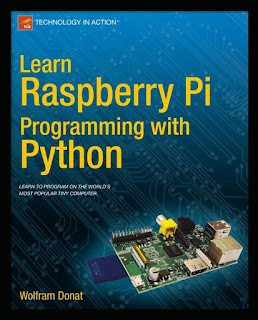Learn Raspberry Pi Programming with Python: LEARN TO PROGRAM ON THE WORLD’S
MOST POPULAR TINY COMPUTER.
Download
Introduction
In 2006, when Eben Upton and the other founders of the Raspberry Pi Foundation looked at the state of Computer
Science (CS) programs in universities, they were dismayed. Computer science programs were being reduced to
“CS 101: How To Operate Microsoft Word” and “CS 203: Optimize Your Facebook Page.” Nobody, they realized, was
learning how to program any more, least of all before they entered college. So they hatched a plan—create a small,
cheap computer that kids could learn to program on, like the Amigas, Spectrums, and Commodore 64s of yesteryear.
hey put an ARM processor on a board, gave it (eventually) 512 MB of RAM and a VideoCore GPU, and allowed
users to interface with it using a USB keyboard, mouse, and an HDMI output port. To make it easy to program, they
designed it so that its main programming language would be Python—a powerful, easy-to-learn scripting language.
And thus the Raspberry Pi was born.
I wrote my irst program in BASIC on a Commodore VIC 20, lo these many years ago. At 5 KB of RAM, it had
less computing power than many of today’s microcontrollers, but I was still able to write a simple maze game on it,
saving my progress as I went on a cassette-tape drive. In the years since, I’ve traversed my way through the diferent
computing platforms, from Windows 3.1, to Macintosh OS 8, to a little bit of Linux. It had been a long time since I was
truly excited by a computer; the Pi was a breath of fresh air in a somewhat stale computing environment. Not only
was it small and cheap, but it was easy to get it to interact with the physical world—a real boon for anybody interested
in designing physical systems. So when I heard about its release, I signed up like about a trillion other hobbyists/
hackers/engineers and waited impatiently for mine to be delivered. hen I started building stuf with it and never
looked back.
If you bought a Pi but aren’t sure how to get started with it, this book is for you.
If you bought a Pi but aren’t sure what to do with it, this book is for you.
If you’re considering buying a Pi but haven’t yet because you keep thinking, “Why should I? It’s not like I can do
anything cool with it, right?”, then this book is deinitely for you.
This book isn’t meant to be a textbook on Python, nor is it an exhaustive exploration of the Raspberry Pi and
everything it can do. But it is meant to be a fun, getting-started guide to this neat little computer. I hope that after you
work your way through the book, you’ll get a sense of all the things that are possible with the Pi when you combine it
with a little ingenuity and creativity on your part.
If you want to work through the projects here in order, feel free.
If you’d rather skip around, doing those that
interest you, you’re welcome to do that as well. Along the way, I hope you’ll develop a familiarity with both Python
and the Pi that will enable you to continue on, building projects as you go, and perhaps inspiring others along the way.
Above all, I hope you enjoy the book and its projects. It was truly a blast to write.
Happy computing!

